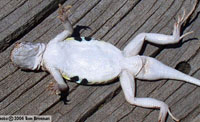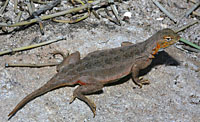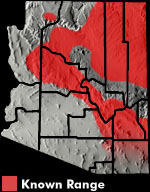Online Field Guide to The Reptiles and Amphibians of Arizona


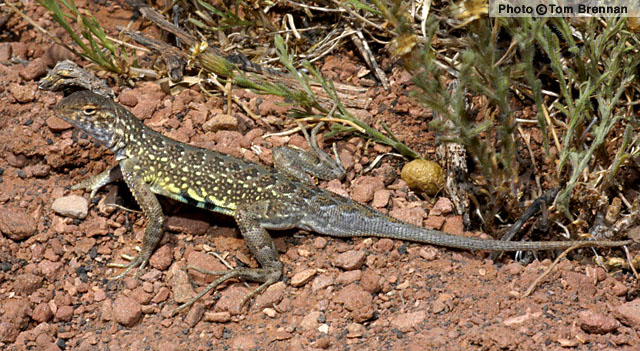
Coconino County, Arizona
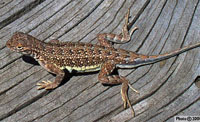 Apache Co., AZ |
| COMMON LESSER EARLESS LIZARD Holbrookia maculata |
|
|
DESCRIPTION: A small (up to 70 mm or 2.75″ from snout to vent), gray, tan, or orange-brown lizard with variable markings. Coloration usually matches the soil on which the lizard lives. Body markings usually consist of four rows of brown blotches or chevrons extending from the neck to the tail and light speckles on the upper surfaces of the body and limbs. Some specimens lack markings. Two black bars mark each lower side of the body just behind the forelimb. Males often have a yellow tint on the lower sides, blue outlines around the side bars, copious light speckling, and less distinct dorsal blotches. Gravid females often have a pink or peach tint and an orange throat patch. As its common name implies, this lizard lacks external ear openings. The scales are small and granular. The paired bars on the lower sides of its body and its lack of ear openings distinguish this lizard from the similar looking Common Side-blotched Lizard. The underside of the tail is plain white distinguishing this lizard from the Greater Earless Lizard. The similar Elegant Earless Lizard has a longer tail, a row of chevron markings that extends to the tip of the tail, and grows to a larger size than the Common Lesser Earless Lizard. DISTRIBUTION: This lizard is distributed across the northeastern plateau region, a portion of the Arizona Strip (land north of the Colorado River), sub-Mogollon Rim central Arizona, and the northernmost sky islands in the southeastern portion of the state. Its boundary with the similar Elegant Earless Lizard to the south is poorly known. In Arizona the Common Lesser Earless Lizard is found at elevations ranging from about 2,200’ to over 7,000’. HABITAT: Found in communities ranging from Semidesert Grassland, through Interior Chaparral, and into woodlands. It also enters Arizona Upland Sonoran Desertscrub in some localities. It is usually encountered on relatively level terrain in open, sunlit areas with sparse vegetation and sandy or gravelly soil. BEHAVIOR: This diurnal lizard is most active mid morning and late afternoon during the hottest months of summer. It can be active throughout the daylight hours in spring and early fall. It hibernates during the cold months of winter and late fall. DIET: The Common Lesser Earless Lizard feeds on a variety of insects including grasshoppers, beetles, bees, wasps, ants, true bugs, butterflies, and moths. It also eats a variety of spiders and small lizards. REPRODUCTION: Mating takes place in spring and one or two clutches of eggs are laid in spring and summer. Clutch size ranges from 1 to 10 eggs. By Thomas C. Brennan Brennan, T. C., & A. T. Holycross. 2006. A Field Guide to Amphibians and Reptiles in Arizona. Arizona Game and Fish Department. Phoenix, AZ Brennan, T. C., & A. T. Holycross. 2005. A Field Guide to Amphibians and Reptiles of Maricopa County. Arizona Game and Fish Department. Phoenix, AZ Degenhardt, W. G., Painter, C. W., and Price, A. H.. 1996. Amphibians and Reptiles of New Mexico. University of New Mexico Press. Albuquerque. Stebbins, R.C. 2003. A Field Guide to Western Reptiles and Amphibians, Third Edition. Houghton Mifflin Company, Boston, MA. |
|
Visit Partners in Amphibian and Reptile Conservation:


HOME
Copyright © 2023, Arizona Game and Fish Department. All rights reserved.
If you make use of the textual contents of this site in reports, publications, etc. please cite and credit the author(s) and photographer(s). All photos on this website are copyrighted. However, those found in the species account section may be used for any noncommercial scientific, educational, or conservation purposes provided that photographs are not altered and continue to bear the copyright symbol and name of the photographer. Please contact the photographer regarding commercial use of copyrighted photographs.










